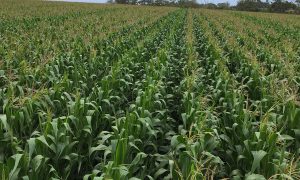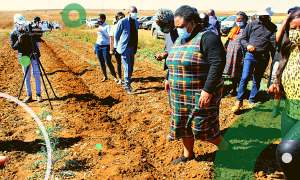When Tiger Brands CEO, Mr Tjaart Kruger, called on farmers to increase local production of wheat, he may have unwittingly stepped onto a long standing issue in the wheat industry, the location differential.
Mr Kruger is right in that South Africa is not self-sufficient on wheat and thus have to constantly import increasing volumes to balance supply and demand. This exposes wheat farmers, buyers and processors to both domestic and global supply and demand dynamics, including volatile exchange rate. Consequently, wheat prices are volatile, negatively affecting planning and budgeting decisions of all role-players in the wheat value chain, including Tiger Brands.
Currently, South Africa produces about 54% of the total domestic requirements. Before the turn of the 21st century, however, South Africa used to produce, on average, 88% of the total wheat requirements. Some seasons, say between 1996 and 1998, the country even managed to produce more than 100%. But then there was a permanent and visible step-down in average production, from 88% to the current average of 60% – a decline of 32%. During the last two seasons, production declined even further (see figure 1).

Why has the above happened and can farmers respond to the call and ramp up hectares (ha) under wheat production, reversing the evident trend? To answer this question, it is useful to review historical developments within the industry. The first historical development occurred on the production side. For more than three decades, hectares under wheat production decreased from 1,56 million hectares in 1990 to current 505 000 ha, a decrease of 68%. Free State is the province that shed the most hectares, from one million hectares to the current 49 000 ha.
Free State farmers possibly stopped the practice of double cropping in drove. Over the same period, total wheat production barely increased, moving from 1,7 million tons to 1,9 million tons (a 15% increase). Domestic consumption outpaced production, increased by 76%, from 2,2 million tons 3,8 million tons. Consequently, import dependency increased significantly with imports increasing by 296%, from 467 000 tons to 1,8 million tons.
The second historical development occurred in the market. Wheat, along with other grains, was marketed through a ‘single channel market system’ with Control Boards, later referred to as Marketing Boards, as single buyers between producers and processors. For more than half a century until 1996, these Marketing Boards were empowered by the Market Act of 1937 to fix grain prices and farmers were required by law to sell through these Marketing Boards, leading to price stability. No ‘side selling’ was allowed under the law.
With the onset of the democratic government, agricultural marketing boards were deregulated through the Marketing Act of 1996, liberating farmers to sell their produce in the free markets. Deregulation and the resulting transition created chaos in relation to transparent price discovery, transmission and price stability.
This was not good for planning decisions of all role players. Anticipating deregulation, the Agricultural Markets Division (AMD) was established 1995 as a division of the South African Futures Exchange (SAFEX), a subsidiary of the Johannesburg Stock Exchange (JSE). Potatoes and beef were the first contracts traded on SAFEX and wheat contracts were introduced in November 1997. The following year, hectares planted to wheat declined by 46% (637 000 hectares), from 1,3 million hectares to 745 000ha and never recovered. Western Cape lost 100 000ha to 300 000ha (25%) while Free State lost 460 000ha (46%) to 330 000ha.
When SAFEX was established, many qualifying delivery points (silos) were established. Wheat has 200 JSE registered silos spread across the country. A single reference point was selected as Randfontein from which the derivative contracts would be referenced whilst delivery would be recognized at various silos. Each silo is allocated a specified and annually reviewed transport discount, also known as location differential.
The intention of a transport discount was to ensure price indifference, enabling delivery from any registered silo across the country whilst a single derivative contract could be traded. This transport discount brought huge discomfort to the Western Cape wheat farmers, so much that two independent studies were commissioned, one by the National Agricultural Market Council (at the behest of Grain SA) and another by the JSE. However, both studies recommended that the JSE maintained the existing system of location differentials.
Without transport discount, buyers closer to Randfontein, which has a higher concentration of wheat processors, will be encouraged to buy from silos in the vicinity of Randfontein. Such preference will disadvantage silos and farmers in faraway places from Randfontein. With location differential, buyers can buy for delivery from any silo around the country. It should be note that wheat, like maize, is a fungible commodity, that loses identify on an owner once stored in a silo, enabling delivery from any silo and trade of silo certificates.
Approximately 50% of the local wheat is produced in the Western Cape, furthest distance from Randfontein. The province has approximately 47% of the wheat registered silos. All the ‘Cape’ silos attract uniform location differential, which happens to be the largest of all other silos due to long distances to Randfontein. For the 2024/25 season, transport discount for the Cape silos was R800/ton. The silo with the lowest location differential of R162/ton was Aureus in Gauteng.
Let me illustrate the impact of transport discounts on the net prices realised by farmers. Spot price of wheat at the time of writing was R5 945/ton. On a net basis, wheat farmers in the Western Cape realise R5 145/ton (R5 945/ton – R800/ton) while those in Gauteng realise a higher net price of R5,783/ton (R5 945/ton – R162/ton). At a lower net price of R5 145/ton, Western Cape farmers must produce more than 3 tons/hectare just to break-even while inland farmers, realising a higher price of R5 783/ton, break-even at lower yields.
This means that, through the system of transport discounts, spot prices of wheat in the Western Cape are always lower than inland spot prices. The implication is that Western Cape farmers are forced to be more productive than Gauteng farmers to be profitable. It is for this reason that many wheat farmers in the Western Cape believe the system of location differential disadvantages them. But are they responsible for production lagging demand? The answer is negative in the affirmative.
Since 1990, wheat yields have been improving at a compound annual growth rate (CAGR) of 4% (see figure 2) but total production has been increasing at a lower rate of 0,4%, largely due to loss of hectares. As an industry, wheat is shedding hectares. Over the same period, domestic consumption has been increasing at CAGR of 2%. Hence, improving yields are insufficient to compensate for the loss of hectares.

To conclude, the current system of locational differentials, though functioning efficiently, clearly does disadvantage Western Cape wheat farmers. But this is just one part of the story as these farmers managed to keep hectares under wheat relatively constant through the years. The challenge at finding a suitable compromise solution is that, on two occasions (in 1999 and 2000), SAFEX introduced the ‘Cape wheat contract’ (SEC), which was discontinued to due to illiquidity. Furthermore, SAFEX investigated the possibility of re-introducing the SEC in 2003 but the market was found not to be in favour. However, we will never know what would have happened had SAFEX given the SEC more seasons to possibly gain momentum and improve liquidity. To answer the questioned asked at the very beginning, it does not seem that South Africa will be able to be self-sufficient on wheat and thus reduce import dependency.
Disclaimer: Views expressed in this article are solely those of Robert Matsila in his personal capacity.




















